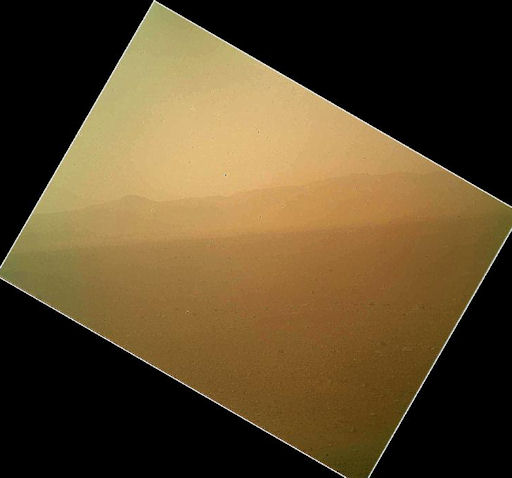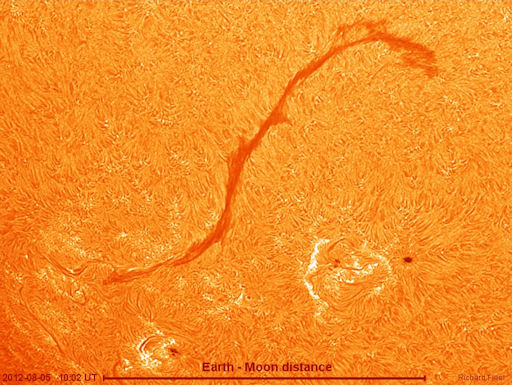Hang the Transit of Venus on your wall! Hubble-quality images from NASA's Solar Dynamics Observatory are now available as metallic posters in the Space Weather Store. | | |
CHANCE OF STORMS: NOAA forecasters estimate a 25% chance of polar geomagnetic storms on August 7/8. That's when a coronal mass ejection (CME) hurled into space by a filament eruption on Aug. 4 could deliver a glancing blow to Earth's magnetic field. Aurora alerts: text, voice.
FIRST COLOR IMAGE FROM CURIOSITY: Curiosity's first color image of Mars has just been beamed back to Earth--and it's a little dusty. This murky view of the landscape to the north of the rover was captured by the Mars Hand Lens Imager (MAHLI) on the afternoon of the first day after landing:

The image shows the north wall and rim of Gale Crater. The view is murky because MAHLI's removable dust cover is apparently coated with dust blown onto the camera during the rover's terminal descent. Another camera, the Descent Imager, photographed the roughly circular swirls of dust kicked up from the Martian surface by the rocket motor exhaust.
The MAHLI camera is located on the turret at the end of Curiosity's robotic arm. The camera's main purpose is to acquire close-up, high-resolution views of rocks and soil at the rover's Gale Crater field site. MAHLI is capable of focusing on any target at distances of about 0.8 inch (2.1 centimeters) to infinity. This means it can take not only close-up pictures of rocks but also big-picture images of the landscape as shown above.
In a week or so, MAHLI's dust cover will come off and the view will improve. Stay tuned for more images.
SUN SERPENT: Amateur astronomers arpund the world are monitoring a gigantic filament of magnetism on the sun. If one end of the filament were on Earth, the other end would reach all the way to the Moon. The dimensions of the structure make it an easy target for amateur solar telescopes. Richard Fleet sends this picture from his backyard observatory in Wiltshire, England:

This filament is filled with billions of tons of plasma, yet it has remained suspended above the surface of the sun for days. Such a massive structure, buffeted as it is by winds and currents in the sun's atmosphere, is unlikely to remain stable much longer. If the filament collapses, it could crash into the surface of the sun and spark a powerful type of explosion called a Hyder flare. Amateur astronomers are encouraged to monitor developments.
Realtime Space Weather Photo Gallery
Realtime Meteor Photo Gallery
Realtime Noctilucent Cloud Photo Gallery
[previous years: 2003, 2004, 2005, 2006, 2007, 2008, 2009, 2011]
Potentially Hazardous Asteroids (
PHAs) are space rocks larger than approximately 100m that can come closer to Earth than 0.05 AU. None of the known PHAs is on a collision course with our planet, although astronomers are finding
new ones all the time.
On August 7, 2012 there were 1324 potentially hazardous asteroids.
Notes: LD means "Lunar Distance." 1 LD = 384,401 km, the distance between Earth and the Moon. 1 LD also equals 0.00256 AU. MAG is the visual magnitude of the asteroid on the date of closest approach. | | The official U.S. government space weather bureau |
| | The first place to look for information about sundogs, pillars, rainbows and related phenomena. |
| | Researchers call it a "Hubble for the sun." SDO is the most advanced solar observatory ever. |
| | 3D views of the sun from NASA's Solar and Terrestrial Relations Observatory |
| | Realtime and archival images of the Sun from SOHO. |
| | from the NOAA Space Environment Center |
| | the underlying science of space weather |

